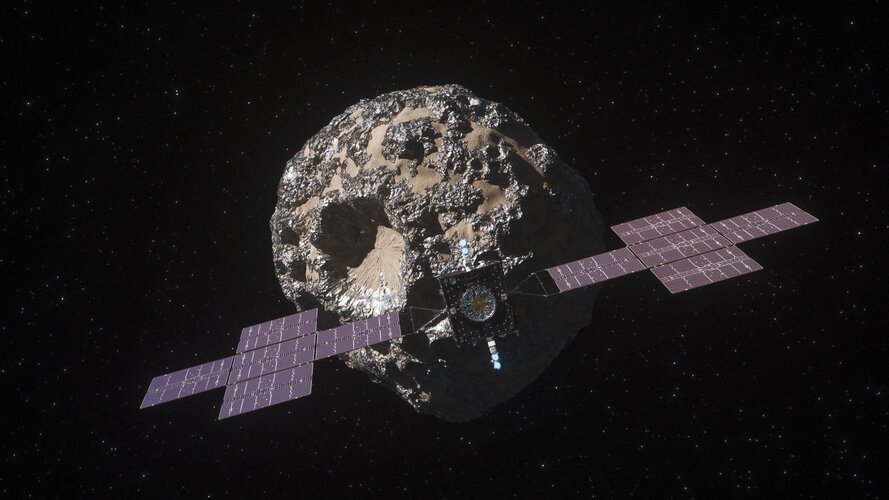Plate tectonics - Mineral olivine is crucial for heat transport in the mantle
Thursday, 10 July 2025 10:48 Due to the radiative thermal conductivity of the mineral olivine, only oceanic plates over 60 million years old and subducting at more than 10 centimeters per year remain sufficiently cold to transport water into the Earth's deep mantle. This was found by scientists from the University of Potsdam and from the Helmholtz Centre for Geosciences (GFZ) Potsdam, together with international colleagues,
Due to the radiative thermal conductivity of the mineral olivine, only oceanic plates over 60 million years old and subducting at more than 10 centimeters per year remain sufficiently cold to transport water into the Earth's deep mantle. This was found by scientists from the University of Potsdam and from the Helmholtz Centre for Geosciences (GFZ) Potsdam, together with international colleagues, Young lunar meteorite sheds light on missing chapter in Moon's volcanic timeline
Thursday, 10 July 2025 10:48 A meteorite discovered in Africa in 2023 has been dated to 2.35 billion years old, making it the youngest known basaltic lunar meteorite and filling a nearly billion-year void in the Moon's volcanic history.
Presented at the Goldschmidt Conference in Prague, the findings from the meteorite Northwest Africa 16286 offer compelling evidence that the Moon maintained internal heat far longer th
A meteorite discovered in Africa in 2023 has been dated to 2.35 billion years old, making it the youngest known basaltic lunar meteorite and filling a nearly billion-year void in the Moon's volcanic history.
Presented at the Goldschmidt Conference in Prague, the findings from the meteorite Northwest Africa 16286 offer compelling evidence that the Moon maintained internal heat far longer th How airports like Heathrow and Gatwick could help aliens spot Earth
Thursday, 10 July 2025 10:48 Radar systems used by civilian airports and military operations are inadvertently revealing our existence to potential advanced alien civilisations, new research shows.
The study explored how hidden electromagnetic leakage might look to extraterrestrials up to 200 light-years from Earth, if they had state-of-the-art radio telescopes like our own. Theoretically, it also suggests this is how
Radar systems used by civilian airports and military operations are inadvertently revealing our existence to potential advanced alien civilisations, new research shows.
The study explored how hidden electromagnetic leakage might look to extraterrestrials up to 200 light-years from Earth, if they had state-of-the-art radio telescopes like our own. Theoretically, it also suggests this is how Redwire integrates second Hammerhead satellite for ESA in-orbit tech mission
Thursday, 10 July 2025 10:48 Redwire Corporation (NYSE: RDW) has finalized integration of its Hammerhead spacecraft platform for a European Space Agency (ESA) in-orbit technology demonstration mission. The work was completed at Redwire's satellite processing facility in Kruibeke, Belgium. As prime contractor, Redwire will support the European Union-funded In-Orbit Demonstration and Verification (IOD/IOV) mission, which aims
Redwire Corporation (NYSE: RDW) has finalized integration of its Hammerhead spacecraft platform for a European Space Agency (ESA) in-orbit technology demonstration mission. The work was completed at Redwire's satellite processing facility in Kruibeke, Belgium. As prime contractor, Redwire will support the European Union-funded In-Orbit Demonstration and Verification (IOD/IOV) mission, which aims China’s orbital maneuvers blur the line between peaceful and provocative
Thursday, 10 July 2025 10:00
Orienspace targets 2025 test flight of Gravity-2 after engine test
Thursday, 10 July 2025 09:37
Chinese commercial launch firm Orienspace is aiming for a late 2025 debut of its Gravity-2 rocket following a recent first-stage engine hot fire test.
Europe's first deep-space optical communication link
Thursday, 10 July 2025 08:02
The European Space Agency (ESA) successfully established a transmission-reception optical link with NASA’s Deep Space Optical Communications (DSOC) experiment onboard its Psyche mission, located 265 million kilometres away, using two optical grounds stations developed for this purpose in Greece.
Trump taps transport chief to be interim NASA administrator
Thursday, 10 July 2025 07:50This request seems a bit unusual, so we need to confirm that you're human. Please press and hold the button until it turns completely green. Thank you for your cooperation!
Press and hold the button
If you believe this is an error, please contact our support team.
185.132.36.159 : dd23964a-bfc1-4da1-bc16-d55df80e
Japan’s Interstellar secures $62 million in series F funding
Thursday, 10 July 2025 07:15
Interstellar Technologies raised 8.9 billion yen ($61.8 million) to boost development of its Zero rocket and research and development of satellite systems.
Secretary of Transportation Duffy named acting NASA administrator
Thursday, 10 July 2025 00:47
In an unprecedented move, President Donald Trump announced late July 9 that he has named Transportation Sec.
Space BD and Gilmour Space to partner on launch and satellite services
Wednesday, 09 July 2025 21:13
Japan’s Space BD has signed an agreement with Australian launch vehicle developer Gilmour Space ahead of that company’s first orbital launch attempt.
Budget reconciliation bill includes tax break for spaceport bonds
Wednesday, 09 July 2025 20:24
Spaceport advocates won a tax break in the budget reconciliation bill that they hope will spur investment, but the provision has also generated a political backlash.
Starlink gets key India approval, but other regulatory hurdles stand in the way of service
Wednesday, 09 July 2025 17:49
India’s space regulator has approved services from Starlink, although SpaceX’s low Earth orbit network still needs spectrum and other clearances before it can provide broadband in the world’s most populous nation.
EnduroSat USA names former DARPA official as CEO to lead U.S. expansion
Wednesday, 09 July 2025 15:04
Paul “Rusty” Thomas was tapped as chief executive of EnduroSat USA, as the company scales up operations.
Space Rider reentry module undergoes 2.5 km drop tests
Wednesday, 09 July 2025 14:19This request seems a bit unusual, so we need to confirm that you're human. Please press and hold the button until it turns completely green. Thank you for your cooperation!
Press and hold the button
If you believe this is an error, please contact our support team.
185.132.36.159 : a2cba841-74dc-4edf-b4c0-0d76c75f

